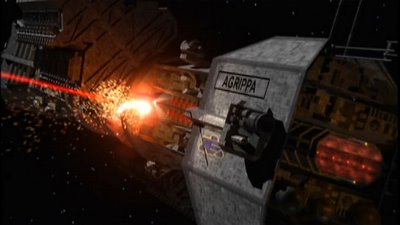You can learn some interesting lessons from the whole process, though. I sharpened up math skills that I hadn’t used for years and re-learned principles of physics and chemistry that I had mostly forgotten. I can easily tell you the difference between a material’s specific heat and its heat of fusion, and I can remember that you need to start correcting kinetic energy estimates for relativity if an object’s speed starts to reach a significant fraction of lightspeed.
Naturally, people have different opinions and heated arguments develop. The argument between fanatical Star Wars fans and fanatical Star Trek fans over which side has superior technology, culture, etc. has gone on for years. B5 fans entered the game late, but they quickly moved to establish their place with the “big boys”.
This is going somewhere; believe me. You see, the usual method for determining who has the more powerful weapon or the faster ship is to treat these television shows and movies as if they were documentaries of actual events (with a hat tip to Galaxy Quest). Scientific analysis of this “documentary evidence” let’s you estimate the power, speed, or other property demonstrated.
 Now, I’m an analyst for the BabTech on the Net website, and we’re working on an update for one of our pages that includes an estimate of a ship’s firepower. In a scene from one episode, one ship melts a line down the hull of another with a laser beam. We can estimate the width of the beam, the length of the line on the hull, and the thickness of the hull to determine how much material melted. Assuming the hull to be steel (an extremely common construction material in modern warships), we can use the thermal properties of iron to estimate the amount of energy required to melt the hull. With this estimate of the energy and the amount of time it took to cause the damage, we can estimate the minimum amount of energy the beam is transferring to its target. The exact results aren’t important, but you can read the analysis if you like.
Now, I’m an analyst for the BabTech on the Net website, and we’re working on an update for one of our pages that includes an estimate of a ship’s firepower. In a scene from one episode, one ship melts a line down the hull of another with a laser beam. We can estimate the width of the beam, the length of the line on the hull, and the thickness of the hull to determine how much material melted. Assuming the hull to be steel (an extremely common construction material in modern warships), we can use the thermal properties of iron to estimate the amount of energy required to melt the hull. With this estimate of the energy and the amount of time it took to cause the damage, we can estimate the minimum amount of energy the beam is transferring to its target. The exact results aren’t important, but you can read the analysis if you like.Another Babylon 5 fansite, the B5 Technical Manual performs a very similar analysis with a couple of key exceptions. After performing all of the steps I described above for analyzing the incident, he finds a result that doesn’t satisfy him, so he makes two additional assumptions:
As we know that the Omega's armor is NOT comprised of iron, and the generalWithout any sound justification, he just inflated his estimate by a factor of about 67. The results of a legitimate scientific analysis didn’t suit him, so he invented additional evidence to make the results fit his expectations.
consensus is that the Earthforce armor is at least 20X stronger than our base
material,....
Also, this is a standard discharge, not a maximum burst. Assuming
that a standard discharge is 30% of critical power,....
Ladies and gentlemen, I have just shown you an example of the Intelligent Design / Creationist mentality in action.
Like the author of the B5Tech analysis, ID proponents don’t like what the evidence tells us about human origins, so they twist the evidence to support the conclusion they want or dismiss it without justification. Michael Behe, for example, claims that living organisms are too complex to have evolved naturally, but he has never produced any evidence to support his claim; he just makes dubious analogies to modern technology and arbitrarily rejects any amount of research showing how complex organisms could or did evolve.
In fact, on cross-examination, Professor Behe was questioned concerning his 1996 claim that science would never find an evolutionary explanation for the immune system. He was presented with fifty-eight peer-reviewed publications, nine books, and several immunology textbook chapters about the evolution of the immune system; however, he simply insisted that this was still not sufficient evidence of evolution, and that it was not "good enough."ID proponents aren’t the only fanatics with this problem, obviously. You see the same attitude in global warming deniers, holocaust deniers, and fanatical trekkies.
-- from the Kitzmiller vs Dover trial decision
The trick for you is to see how biased presenters introduce hidden assumptions, alter evidence, change standards, or fix analytical methods to achieve the results they wanted from the beginning. A good scientific analysis will define its assumptions and methods before presenting and analyzing the evidence, allowing you to judge the quality of their process before you judge their results.

3 comments:
Nice. Where would the world be without those who obsess, eh?
Geekdom Saves!
Another B5 fan. Just started reading Techno-mage trilogy.
finalz.blogspot.com
"Babylon 5 is probably my favorite science fiction series of all time. In my opinion, its story surpasses Star Wars, Star Trek, and every other SF tale told to date."
For me BABYLON 5 was and is the best science-fiction on television. The STAR WARS saga was and is the best science-fiction saga ever seen on the movie.
As to which saga is the best . . . it's a toss up for me.
Post a Comment